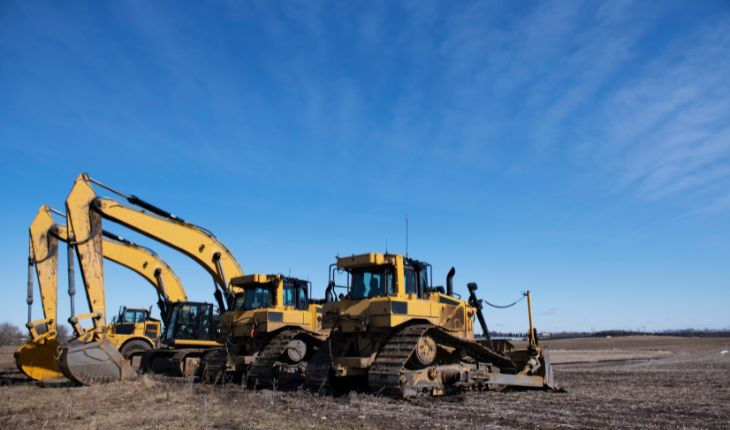Driving Infrastructure with Next-Gen Heavy Equipment
- Sophia Grace
- Aug 13
- 4 min read
Heavy construction equipment stands at the core of modern infrastructure development, enabling the creation of roads, bridges, skyscrapers, and massive industrial facilities. From earthmoving giants to advanced cranes and paving machinery, these machines transform architectural visions into reality. The industry’s growth is fueled by rapid urbanization, large-scale infrastructure investments, and technological innovations that are making equipment more efficient, durable, and environmentally friendly. With the construction sector evolving to meet higher standards of safety, speed, and sustainability, heavy equipment has become more than just a tool—it’s the driving force behind progress.

Insights from Expert Market Research
According to Expert Market Research, the heavy construction equipment industry size is witnessing robust expansion due to rising infrastructure projects, urban redevelopment initiatives, and increased demand for advanced machinery with improved performance capabilities. Key factors driving this growth include the adoption of automation, hybrid and electric-powered equipment, and telematics for real-time performance monitoring. Expert Market Research emphasizes that construction companies are investing heavily in equipment that reduces fuel consumption, lowers emissions, and offers enhanced operator comfort. As governments prioritize sustainable infrastructure, the demand for next-generation machines designed for efficiency and eco-friendliness is on a sharp upward curve.
Technological Innovations Redefining the Industry
Technology is transforming how heavy construction equipment operates on job sites. Automation and semi-autonomous machinery are improving precision, reducing labor requirements, and increasing productivity. GPS-enabled grading systems, drone-assisted site surveys, and 3D machine control allow operators to work with unprecedented accuracy, cutting project timelines and minimizing material waste. The integration of IoT sensors is giving equipment operators and managers real-time insights into machine health, fuel efficiency, and operational performance.
Electric and hybrid models are also entering the market, providing quieter operations, reduced emissions, and lower operational costs. This trend aligns with the global push for greener construction practices and helps companies meet environmental regulations while enhancing their competitive edge.
The Role of Heavy Equipment in Infrastructure Growth
From urban transit systems and airports to dams and highways, heavy equipment is indispensable for executing large-scale infrastructure projects. Earthmovers prepare and level the ground, cranes assemble massive steel frameworks, and concrete mixers ensure structures have the necessary strength and durability. Without these machines, completing complex projects within tight deadlines would be nearly impossible.
Heavy construction equipment also plays a key role in disaster recovery and redevelopment. In regions affected by earthquakes, floods, or storms, equipment such as excavators, loaders, and bulldozers helps clear debris, restore access routes, and rebuild essential facilities.
Changing Market Demands and Operator Expectations
The industry is seeing a shift toward machines that not only perform well but also enhance operator comfort and safety. Modern cabs feature ergonomic seating, advanced climate control, and intuitive control systems to reduce fatigue during long shifts. Safety enhancements such as collision detection, 360-degree cameras, and proximity alerts are becoming standard in high-end models.
Contractors are also looking for versatile equipment that can handle multiple tasks, reducing the need for an extensive fleet. This has led to the development of multifunctional machines equipped with interchangeable attachments, enabling faster transitions between tasks like digging, lifting, and grading.
Heavy Equipment and the Push for Sustainability
Sustainability has become a central priority for the construction sector, and equipment manufacturers are responding with innovations that reduce environmental impact. Low-emission engines, biodegradable hydraulic fluids, and energy-efficient components are becoming more common. Equipment designed for lower fuel consumption not only supports environmental goals but also reduces operating expenses, offering contractors a dual advantage.
Additionally, many companies are incorporating remanufacturing and recycling programs to extend the life cycle of parts and reduce waste. This approach aligns with circular economy principles and enhances brand reputation among environmentally conscious clients.
Regional Growth Trends and Opportunities
The demand for heavy construction equipment is growing across all major regions, but the drivers vary. In North America, aging infrastructure is spurring massive investments in bridge repair, road resurfacing, and public transit expansion. In Asia, rapid urbanization and industrialization are driving high demand for earthmoving and road construction equipment. The Middle East is investing heavily in large-scale projects, including smart cities and mega transport hubs, creating opportunities for high-capacity machinery.
Emerging markets in Africa and Southeast Asia are also seeing increased adoption of heavy equipment due to foreign investment in infrastructure and mining projects. The combination of affordable financing options and rental services is making advanced machinery accessible to smaller contractors in these regions.
The Road Ahead: A More Intelligent and Connected Future
The future of heavy construction equipment lies in smarter, more connected, and environmentally responsible machinery. Artificial intelligence and predictive analytics will enable equipment to anticipate maintenance needs, reducing downtime and extending operational life. Fully autonomous machines may soon become a reality on large, repetitive projects, freeing human operators for more complex tasks.
As the construction industry continues to expand and diversify, heavy construction equipment will remain its backbone—evolving with each technological leap, environmental requirement, and market demand. Those who embrace innovation and invest in advanced machinery will be best positioned to shape the infrastructure of tomorrow.









Comments